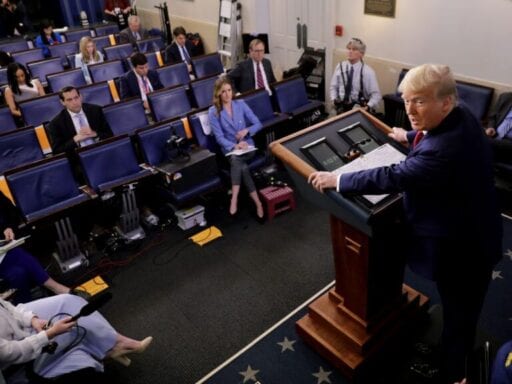Endless repetition of the same handful of talking points is not helping the president seem substantive.
The White House’s coronavirus press briefing on the afternoon of Saturday, April 4, was grueling to watch. It lasted more than 90 minutes, and much of it was dominated by President Trump making the same handful of statements, worded only slightly differently, over and over and over. (At one point, he said “We have to open our country again” so many times, I thought he might be stuck.) And the briefings since then have been no different. At Monday’s briefing, Trump hit many of the same themes, particularly his favorite: how awful the media is.
What I noticed throughout Saturday’s presentation was how little new information Trump had to offer. He kept repeating his favorite talking points from the entirety of this ordeal — including that an unproven drug could be the magic bullet to take down Covid-19, that maybe churches should open up for Easter Sunday, and yet another gentle gibe about how Mike Pence doesn’t seem to be sleeping a lot. (In his treatment of Pence, he reminds me a lot of the worst boss I’ve ever had, a man who would learn one tiny detail about each of his employees, then relentlessly riff on that detail for as long as they might work for him.)
There were a few newer snippets within Trump’s stream-of-consciousness ramble. He said there’s going to be “a lot of death” in the country this week, and he went on a long tangent where he named all the heads of major American sports leagues.
But even when Trump was saying nominally new things, I couldn’t shake the feeling that I’d heard all of this before. And then I realized the best possible comparison point for his performance on Saturday and at every other press conference: a clip show.
Having nothing new to say is a natural offshoot of Trump doing a press conference nearly every day. But he abhors dead air.
/cdn.vox-cdn.com/uploads/chorus_asset/file/19882495/1208678202.jpg.jpg) Manel Ngan/AFP via Getty Images
Manel Ngan/AFP via Getty ImagesThe much-derided “clip show” is an episode of a TV series that stitches together clips from past episodes, usually with a loose framing device — the Simpson family, for example, sitting around and reminiscing about old times.
Clip shows are basically never good, but they’re often a budgetary necessity. (A notable exception: the fun “fake” clip shows produced by programs like the animated Clerks series and Community, which feature the characters remembering adventures the audience had never gotten to see. But fake clip shows tend to be incredibly expensive, so they don’t have the one benefit of a traditional clip show.) In TV seasons with 22 episodes or more, a clip show is a good way for a series to give everyone involved a light workweek and to save money by not hiring guest stars or building new sets. If 15 to 18 minutes of a 21-minute running time is taken up by previously aired footage, you can see how putting together a clip show would amount to a much-needed break during a taxing production schedule.
Bearing that in mind, it’s easy to imagine a press briefing where Trump might say something like, “Remember that time I said we had to open up our country again?” before looking off to the side as that clip played, so everybody could remember the time he said just that. In many ways, it would accomplish the same function as his current press briefings, and better underline whatever new information he has to share.
This vague clip show feel is the natural consequence of Trump’s insistence on doing near-daily briefings that play into his love of high ratings. There won’t be new information on the coronavirus every single day, beyond updating the number of confirmed cases and number of deaths. But if Trump is going to fill airtime, he needs something to talk about. Hence, the repetition, the restatement, the sense that we’ve heard him cover all the same ground many times before.
(Another comparison to draw here might be to cable news networks and the 24-hour news cycle, where anchors are forced to talk a lot, even when they don’t have any new developments to share. Yet on a cable news network, anchors can interview experts or people affected by the pandemic. They can show footage from beleaguered hospitals, or they can talk about other stories in the news. Trump keeps recycling the same material.)
This monotony might be alleviated if Trump were an esteemed virologist with a unique understanding of infectious diseases. (I know, I know.) It might even be alleviated if he turned over the podium more often to Dr. Anthony Fauci or even to Pence. I don’t know what, precisely, Pence could say that we haven’t already heard, but at least watching him speak would be something different. Trump has occasionally tried this strategy, as when MyPillow founder Mike Lindell offered a brief statement on how God had blessed America by making Trump our president at a press conference in March. But these guest spots rarely last long.
To let someone else become the center of attention for too long runs counter to everything Trump knows how to do. So he talks and talks and talks, and he barely says anything new, but at least there’s very little dead air. If there’s one thing Trump knows television can’t abide, it’s dead air.
My guess is that the monotonous repetition is starting to hurt Trump more than it’s helping him, and indeed, his poll numbers are starting to slump. As Trump keeps repeating the same things, the disconnect between his clip show press briefings and the increasingly dire situation of the country grows ever wider. A clip show might be an occasional necessity during a TV show’s run, but a season made up entirely of them would probably exhaust the patience of even the most forgiving viewer.
Author: Emily Todd VanDerWerff
Read More



